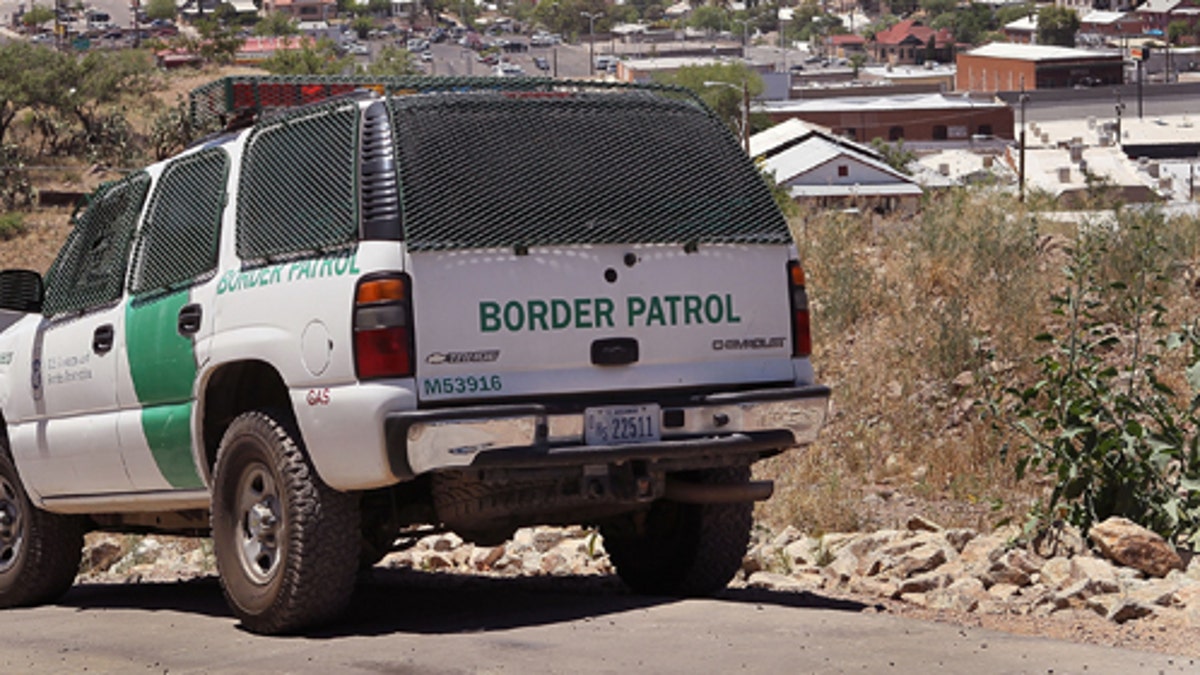
NOGALES, AZ - JUNE 01: A Border Patrol agent patrols the border June 1, 2010 in Nogales, Arizona. During the 2009 fiscal year 540,865 undocumented immigrants were apprehended entering the United States illegally along the Mexican border, 241,000 of those were captured along this 262 mile stretch of the border known as the Tucson Sector. (Photo by Scott Olson/Getty Images) (2010 Getty Images)
Houston – Immigrants from Central America account for a slight majority of the agency's recent apprehensions in South Texas, Border Patrol officials said Friday.
They're coming mainly from Central American countries, including El Salvador, Guatemala and Honduras, said Rosendo Hinojosa, chief of the Rio Grande Valley Border Patrol Sector.
"Usually, about 35 percent of the population that this sector catches" is non-Mexican migrants, Hinojosa said. "Right now we are trending above that. We're about 50/50 right now. There is no indication that this will be a long-term phenomenon. It's just too early to tell."
From October 2011 to July 31, agents apprehended more than 40,000 non-Mexican migrants, compared to about 39,000 individuals from Mexico. The number of non-Mexican migrants apprehended during the same 10-month period a year earlier was about 16,000.
Hinojosa said the figures are unusual but not unheard of, as his sector, which spans 17,000 square miles, traditionally has been an entry point for undocumented immigrants from Central America.
"Central Americans have always been a staple, if you will, of our apprehensions. So, it seems that they are continuing that trend," he said.
Experts have said rising violence fueled in part by Mexican drug cartels moving into Central America as well as poor economic conditions are probably fueling the increase in migrants from there.
The sector has seen other waves in apprehensions of non-Mexican migrants. In 2005, 35,000 Brazilians were caught trying to illegally enter the country. Between October 2009 and March 2011, agents detained at least 2,600 undocumented immigrants from India, a dramatic rise over the typical 150 to 300 arrests per year. Numbers for both nationalities have since dropped.
As the number of Central American migrants has gone up, the number of undocumented immigrants from Mexico, who still make up the majority of apprehensions nationwide, has been steadily declining.
A study released earlier this year by the Pew Hispanic Center, a Washington-based think tank, said the illegal migration of Mexicans to the United States is at its lowest level in decades, due in part to the sluggish American economy and fewer job opportunities, particularly in the housing and construction industries.
While apprehensions in general have been declining nationwide over the last few years, the Rio Grande Valley sector's numbers increased. From October 2011 to July 31, the sector had 79,000 total apprehensions, up from 48,000 for the same 10-month period a year earlier.
Hinojosa attributes the overall increase in apprehensions to more agents in his sector —from 1,850 in 2007 to 2,500 agents now. Strategies to control the flow of undocumented immigrants also have improved over the last two years, he said.
Border Patrol agents in South Texas have also seen an increase in the number of illegal immigrant deaths and rescues of migrants.
In 2011, the Rio Grande Valley sector had 66 deaths and 238 rescues. In 2012, there were 140 deaths and more than 300 rescues. In the first 2½ months of the current fiscal year, there have been more than 40 deaths and more than 130 rescues.
Hinojosa said the Border Patrol is working with consulates from Mexico and various Central American countries to inform people about the potential dangers undocumented immigrants face when trying to enter the United States, most of which, he said, come at the hands of smugglers.
"We understand there is a desire for people that are not in this country to come to this country," he said. "We just want to highlight the significant risk that's associated with that type of transaction."
Based on reporting by the Associated Press.
Follow us on twitter.com/foxnewslatino
Like us at facebook.com/foxnewslatino




